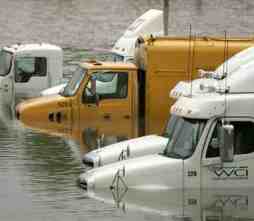 KANSAS CITY, Mo (Reuters) – Some 300 residents of a northwest Missouri town were under orders to evacuate because of two breaches in Missouri River levees and expectations that water will top secondary barriers, officials said on Tuesday.
KANSAS CITY, Mo (Reuters) – Some 300 residents of a northwest Missouri town were under orders to evacuate because of two breaches in Missouri River levees and expectations that water will top secondary barriers, officials said on Tuesday.
Heavy rains across the Missouri River basin added to woes Tuesday as the swollen river and its tributaries pressured levees and flooded areas from Montana through Missouri, forcing evacuations and road and rail closings.
Water breached Missouri River levees about three miles south and west of Craig, Missouri, and was expected to top recently fortified earthen and sandbag barriers around the town, Holt County Commissioner Bill Gordon said Tuesday.
“Water is headed this way,” Gordon said. “People are pretty stressed out.”
A bank, post office and restaurant in downtown Craig already had moved out in expectation of flooding, Gordon said.
In recent days breaches have inundated some farmland and homes, particularly around the village of Big Lake, Missouri.
Levees have also failed in Atchison County north of Holt County. Most people had voluntarily evacuated those areas before the flood, officials have said. The flooding has closed numerous highways in the two counties and Big Lake State Park.
A levee breached near Hamburg, Iowa, more than a week ago and floodwaters are up against a secondary levee.
The rains were coupled with record water releases from six U.S. Army Corps of Engineers operated dams from Montana through South Dakota to relieve pressure on reservoirs swollen by snow melt and heavy rains last month.
Peak releases are planned until at least mid-August and high flows are expected until December.
Heavy rain stretched across Nebraska through South Dakota and into Minnesota Monday into Tuesday.
TORNADOES BY THE DOZEN
More than three dozen reports of tornadoes were logged in northwest Kansas and southern Nebraska from Monday afternoon to evening with no serious injuries, though damaging homes, cars and power lines, the National Weather Service said.
In Nebraska, thunderstorms brought hail more than an inch in diameter and wind gusts reported up to 70 miles per hour, knocking down trees and power lines, damaging farmsteads and tearing the roof off a house, the weather service said.
Flooding and heavier water flows have forced the closure of bridge crossings of the Missouri River from just south of Omaha for more than 100 miles south. More bridges and railroad lines may have to close as flooding continues.
Power has been restored to nearly all of the roughly 11,600 residences that lost power in the Omaha area, said Mike Jones a senior media specialist with the Omaha Public Power District.
North of Omaha, the Fort Calhoun nuclear power station remains shut down due to Missouri River flooding, but protected by temporary flood barriers and dry, Jones said. Two coal-burning power plants along the river are operating and also protected by flood barriers, he said.
The Nebraska Public Power District was assessing damage to 50 transmission structures, likely from tornadoes, media relations specialist Mark Becker said.
Near Brownville in southeastern Nebraska, the Cooper nuclear power station is operating and protected by flood barriers, Becker said. The river actually dipped nearly 4 inches in the past day, he said.
In North Dakota and South Dakota the rains strained pumps that clear water from streets when flood barriers prevent runoff into the river.
The weather service issued a flash flood warning after the Pierre, South Dakota area received 3 inches of rain on Monday and up to 2 inches more were possible.
Hayes, South Dakota, about 35 miles west of Pierre, reported more than 4 inches of rain, and 7 inches of rain were reported near Fort Thompson southeast of Pierre.
In North Dakota, rains added to flooding on the Red River tributary Souris River at Minot. Amtrak said on Tuesday it had suspended Empire Builder service in part of Minnesota, all of North Dakota and eastern Montana due to Minot-area flooding.
(Additional reporting by David Bailey in Minneapolis; Editing by Jerry Norton)


